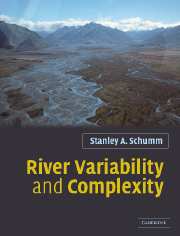Book contents
Chapter 3 - Non-regime channels
Published online by Cambridge University Press: 05 June 2012
Summary
Except for the mountain streams discussed in Chapter 2, all of the other channels were alluvial and in regime. Therefore, it is appropriate here to spend some time considering channels that are responding to altered conditions by eroding, depositing, avulsing, and changing pattern – i.e., non-regime channels.
Rivers respond to altered conditions, therefore variability through time is important because a river or a reach may be out of character for a period as it adjusts. For example, Table 2.2 suggests how different types of channels respond to change. A list of 16 responses of channels to change, and the four major variables that influence them are summarized in Table 3.1. Time (history) is included with discharge (increase or decrease), sediment load (increase or decrease), and base level change (up or down), because channels change naturally through time, and time is an index of energy expended or work done. The changes are grouped according to the results of the change (erosion, deposition, pattern change, and metamorphosis). In Table 3.1, the changes that will be affected by the passage of time or by a change of discharge, sediment load or base level are indicated by an X. A brief discussion of each of the responses follows, but two – incision and avulsion – will be considered in detail because of their potential for causing serious problems.
- Type
- Chapter
- Information
- River Variability and Complexity , pp. 18 - 36Publisher: Cambridge University PressPrint publication year: 2005



